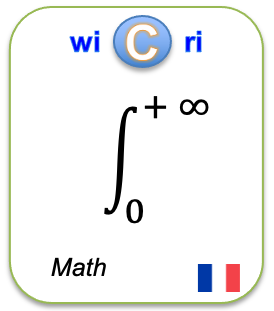Crystalline cohomology and GL(2, ℚ)
Identifieur interne : 001A59 ( Istex/Checkpoint ); précédent : 001A58; suivant : 001A60Crystalline cohomology and GL(2, ℚ)
Auteurs : Gerd Faltings [États-Unis] ; Bruce W. Jordan [États-Unis]Source :
- Israel Journal of Mathematics [ 0021-2172 ] ; 1995-10-01.
Descripteurs français
- Wicri :
- geographic : Jordanie.
English descriptors
- KwdEn :
- Algebra, Cohomology, Cohomology class, Companion form, Companion forms, Comparison theorem, Cond, Constant coefficients, Constant term, Constant terms, Crystalline, Crystalline cohomology, Crystalline methods, Crystalline theory, Cusp, Cusp form, Cusp forms, Dirichlet, Dirichlet character, Dirichlet characters, Duality, Eigenvalue, Eisenstein, Eisenstein case, Eisenstein ideals, Eisenstein series, Elliptic, Elliptic curve, Elliptic curves, Exact order, Exact sequence, Faltings, Filtration, Finite extension, Frobenius, Frobenius element, Functional equation, Galois, Galois representations, Good reduction, Hecke, Hecke algebra, Hecke correspondence, Hecke correspondences, Hecke eigenvalues, Hecke operators, Higher weight, Inertia, Inertia subgroup, Inventiones mathematicae, Irreducible, Isogeny, Isomorphic, Isomorphism, Jordan, Local requirements, Math, Maximal, Maximal ideals, Modp, Modular, Modular form, Modular forms, Modular representations, Module, Modulo, Modulus, Multiplicative, Nebentypus character, Notation, Number theory, Ordinary locus, Other hand, Parametrized, Parametrized cusp, Positive integer, Power series, Primitive vector, Quotient, Ramified, Reducible, Residue field, Rham, Second factor, Serre, Serre duality, Sheaf, Simple poles, Special fiber, Subgroup, Symm, Tamely ramified, Tate curve, Universal elliptic curve, Unramified.
- Teeft :
- Algebra, Cohomology, Cohomology class, Companion form, Companion forms, Comparison theorem, Cond, Constant coefficients, Constant term, Constant terms, Crystalline, Crystalline cohomology, Crystalline methods, Crystalline theory, Cusp, Cusp form, Cusp forms, Dirichlet, Dirichlet character, Dirichlet characters, Duality, Eigenvalue, Eisenstein, Eisenstein case, Eisenstein ideals, Eisenstein series, Elliptic, Elliptic curve, Elliptic curves, Exact order, Exact sequence, Faltings, Filtration, Finite extension, Frobenius, Frobenius element, Functional equation, Galois, Galois representations, Good reduction, Hecke, Hecke algebra, Hecke correspondence, Hecke correspondences, Hecke eigenvalues, Hecke operators, Higher weight, Inertia, Inertia subgroup, Inventiones mathematicae, Irreducible, Isogeny, Isomorphic, Isomorphism, Jordan, Local requirements, Math, Maximal, Maximal ideals, Modp, Modular, Modular form, Modular forms, Modular representations, Module, Modulo, Modulus, Multiplicative, Nebentypus character, Notation, Number theory, Ordinary locus, Other hand, Parametrized, Parametrized cusp, Positive integer, Power series, Primitive vector, Quotient, Ramified, Reducible, Residue field, Rham, Second factor, Serre, Serre duality, Sheaf, Simple poles, Special fiber, Subgroup, Symm, Tamely ramified, Tate curve, Universal elliptic curve, Unramified.
Abstract
Abstract: This paper applies recent advances in crystalline cohomology to the classical case of open elliptic modular curves. In so doing control is gained over the action of inertia in the Galois representations attached to modular forms. Our aim is to study the modular Galois representations attached to automorphic forms modp of weightk≥2. We generalize to higher weightk several results which were previously accessible only in the case of weight 2 where jacobian varieties can be invoked. Additionally we reconsider Gross’s theorem on companion forms in a crystalline context.
Url:
DOI: 10.1007/BF02783205
Affiliations:
Links toward previous steps (curation, corpus...)
Links to Exploration step
ISTEX:3944615936504C09CDB8A0094DD69905C9EF510ELe document en format XML
<record><TEI wicri:istexFullTextTei="biblStruct"><teiHeader><fileDesc><titleStmt><title xml:lang="en">Crystalline cohomology and GL(2, ℚ)</title><author><name sortKey="Faltings, Gerd" sort="Faltings, Gerd" uniqKey="Faltings G" first="Gerd" last="Faltings">Gerd Faltings</name></author><author><name sortKey="Jordan, Bruce W" sort="Jordan, Bruce W" uniqKey="Jordan B" first="Bruce W." last="Jordan">Bruce W. Jordan</name></author></titleStmt><publicationStmt><idno type="wicri:source">ISTEX</idno><idno type="RBID">ISTEX:3944615936504C09CDB8A0094DD69905C9EF510E</idno><date when="1995" year="1995">1995</date><idno type="doi">10.1007/BF02783205</idno><idno type="url">https://api.istex.fr/document/3944615936504C09CDB8A0094DD69905C9EF510E/fulltext/pdf</idno><idno type="wicri:Area/Istex/Corpus">000B79</idno><idno type="wicri:explorRef" wicri:stream="Istex" wicri:step="Corpus" wicri:corpus="ISTEX">000B79</idno><idno type="wicri:Area/Istex/Curation">000B79</idno><idno type="wicri:Area/Istex/Checkpoint">001A59</idno><idno type="wicri:explorRef" wicri:stream="Istex" wicri:step="Checkpoint">001A59</idno></publicationStmt><sourceDesc><biblStruct><analytic><title level="a" type="main" xml:lang="en">Crystalline cohomology and GL(2, ℚ)</title><author><name sortKey="Faltings, Gerd" sort="Faltings, Gerd" uniqKey="Faltings G" first="Gerd" last="Faltings">Gerd Faltings</name><affiliation wicri:level="4"><country xml:lang="fr">États-Unis</country><wicri:regionArea>Department of Mathematics, Princeton University, 08544, Princeton, NJ</wicri:regionArea><placeName><region type="state">New Jersey</region><settlement type="city">Princeton (New Jersey)</settlement></placeName><orgName type="university">Université de Princeton</orgName></affiliation></author><author><name sortKey="Jordan, Bruce W" sort="Jordan, Bruce W" uniqKey="Jordan B" first="Bruce W." last="Jordan">Bruce W. Jordan</name><affiliation wicri:level="2"><country xml:lang="fr">États-Unis</country><wicri:regionArea>Department of Mathematics, Baruch College, CUNY, 17 Lexington Avenue, Box 509, 10010, New York, NY</wicri:regionArea><placeName><region type="state">État de New York</region></placeName></affiliation></author></analytic><monogr></monogr><series><title level="j">Israel Journal of Mathematics</title><title level="j" type="abbrev">Israel J. Math.</title><idno type="ISSN">0021-2172</idno><idno type="eISSN">1565-8511</idno><imprint><publisher>Springer-Verlag</publisher><pubPlace>New York</pubPlace><date type="published" when="1995-10-01">1995-10-01</date><biblScope unit="volume">90</biblScope><biblScope unit="issue">1-3</biblScope><biblScope unit="page" from="1">1</biblScope><biblScope unit="page" to="66">66</biblScope></imprint><idno type="ISSN">0021-2172</idno></series></biblStruct></sourceDesc><seriesStmt><idno type="ISSN">0021-2172</idno></seriesStmt></fileDesc><profileDesc><textClass><keywords scheme="KwdEn" xml:lang="en"><term>Algebra</term><term>Cohomology</term><term>Cohomology class</term><term>Companion form</term><term>Companion forms</term><term>Comparison theorem</term><term>Cond</term><term>Constant coefficients</term><term>Constant term</term><term>Constant terms</term><term>Crystalline</term><term>Crystalline cohomology</term><term>Crystalline methods</term><term>Crystalline theory</term><term>Cusp</term><term>Cusp form</term><term>Cusp forms</term><term>Dirichlet</term><term>Dirichlet character</term><term>Dirichlet characters</term><term>Duality</term><term>Eigenvalue</term><term>Eisenstein</term><term>Eisenstein case</term><term>Eisenstein ideals</term><term>Eisenstein series</term><term>Elliptic</term><term>Elliptic curve</term><term>Elliptic curves</term><term>Exact order</term><term>Exact sequence</term><term>Faltings</term><term>Filtration</term><term>Finite extension</term><term>Frobenius</term><term>Frobenius element</term><term>Functional equation</term><term>Galois</term><term>Galois representations</term><term>Good reduction</term><term>Hecke</term><term>Hecke algebra</term><term>Hecke correspondence</term><term>Hecke correspondences</term><term>Hecke eigenvalues</term><term>Hecke operators</term><term>Higher weight</term><term>Inertia</term><term>Inertia subgroup</term><term>Inventiones mathematicae</term><term>Irreducible</term><term>Isogeny</term><term>Isomorphic</term><term>Isomorphism</term><term>Jordan</term><term>Local requirements</term><term>Math</term><term>Maximal</term><term>Maximal ideals</term><term>Modp</term><term>Modular</term><term>Modular form</term><term>Modular forms</term><term>Modular representations</term><term>Module</term><term>Modulo</term><term>Modulus</term><term>Multiplicative</term><term>Nebentypus character</term><term>Notation</term><term>Number theory</term><term>Ordinary locus</term><term>Other hand</term><term>Parametrized</term><term>Parametrized cusp</term><term>Positive integer</term><term>Power series</term><term>Primitive vector</term><term>Quotient</term><term>Ramified</term><term>Reducible</term><term>Residue field</term><term>Rham</term><term>Second factor</term><term>Serre</term><term>Serre duality</term><term>Sheaf</term><term>Simple poles</term><term>Special fiber</term><term>Subgroup</term><term>Symm</term><term>Tamely ramified</term><term>Tate curve</term><term>Universal elliptic curve</term><term>Unramified</term></keywords><keywords scheme="Teeft" xml:lang="en"><term>Algebra</term><term>Cohomology</term><term>Cohomology class</term><term>Companion form</term><term>Companion forms</term><term>Comparison theorem</term><term>Cond</term><term>Constant coefficients</term><term>Constant term</term><term>Constant terms</term><term>Crystalline</term><term>Crystalline cohomology</term><term>Crystalline methods</term><term>Crystalline theory</term><term>Cusp</term><term>Cusp form</term><term>Cusp forms</term><term>Dirichlet</term><term>Dirichlet character</term><term>Dirichlet characters</term><term>Duality</term><term>Eigenvalue</term><term>Eisenstein</term><term>Eisenstein case</term><term>Eisenstein ideals</term><term>Eisenstein series</term><term>Elliptic</term><term>Elliptic curve</term><term>Elliptic curves</term><term>Exact order</term><term>Exact sequence</term><term>Faltings</term><term>Filtration</term><term>Finite extension</term><term>Frobenius</term><term>Frobenius element</term><term>Functional equation</term><term>Galois</term><term>Galois representations</term><term>Good reduction</term><term>Hecke</term><term>Hecke algebra</term><term>Hecke correspondence</term><term>Hecke correspondences</term><term>Hecke eigenvalues</term><term>Hecke operators</term><term>Higher weight</term><term>Inertia</term><term>Inertia subgroup</term><term>Inventiones mathematicae</term><term>Irreducible</term><term>Isogeny</term><term>Isomorphic</term><term>Isomorphism</term><term>Jordan</term><term>Local requirements</term><term>Math</term><term>Maximal</term><term>Maximal ideals</term><term>Modp</term><term>Modular</term><term>Modular form</term><term>Modular forms</term><term>Modular representations</term><term>Module</term><term>Modulo</term><term>Modulus</term><term>Multiplicative</term><term>Nebentypus character</term><term>Notation</term><term>Number theory</term><term>Ordinary locus</term><term>Other hand</term><term>Parametrized</term><term>Parametrized cusp</term><term>Positive integer</term><term>Power series</term><term>Primitive vector</term><term>Quotient</term><term>Ramified</term><term>Reducible</term><term>Residue field</term><term>Rham</term><term>Second factor</term><term>Serre</term><term>Serre duality</term><term>Sheaf</term><term>Simple poles</term><term>Special fiber</term><term>Subgroup</term><term>Symm</term><term>Tamely ramified</term><term>Tate curve</term><term>Universal elliptic curve</term><term>Unramified</term></keywords><keywords scheme="Wicri" type="geographic" xml:lang="fr"><term>Jordanie</term></keywords></textClass><langUsage><language ident="en">en</language></langUsage></profileDesc></teiHeader><front><div type="abstract" xml:lang="en">Abstract: This paper applies recent advances in crystalline cohomology to the classical case of open elliptic modular curves. In so doing control is gained over the action of inertia in the Galois representations attached to modular forms. Our aim is to study the modular Galois representations attached to automorphic forms modp of weightk≥2. We generalize to higher weightk several results which were previously accessible only in the case of weight 2 where jacobian varieties can be invoked. Additionally we reconsider Gross’s theorem on companion forms in a crystalline context.</div></front></TEI><affiliations><list><country><li>États-Unis</li></country><region><li>New Jersey</li><li>État de New York</li></region><settlement><li>Princeton (New Jersey)</li></settlement><orgName><li>Université de Princeton</li></orgName></list><tree><country name="États-Unis"><region name="New Jersey"><name sortKey="Faltings, Gerd" sort="Faltings, Gerd" uniqKey="Faltings G" first="Gerd" last="Faltings">Gerd Faltings</name></region><name sortKey="Jordan, Bruce W" sort="Jordan, Bruce W" uniqKey="Jordan B" first="Bruce W." last="Jordan">Bruce W. Jordan</name></country></tree></affiliations></record>Pour manipuler ce document sous Unix (Dilib)
EXPLOR_STEP=$WICRI_ROOT/Wicri/Mathematiques/explor/BourbakiV1/Data/Istex/Checkpoint
HfdSelect -h $EXPLOR_STEP/biblio.hfd -nk 001A59 | SxmlIndent | more
Ou
HfdSelect -h $EXPLOR_AREA/Data/Istex/Checkpoint/biblio.hfd -nk 001A59 | SxmlIndent | more
Pour mettre un lien sur cette page dans le réseau Wicri
{{Explor lien
|wiki= Wicri/Mathematiques
|area= BourbakiV1
|flux= Istex
|étape= Checkpoint
|type= RBID
|clé= ISTEX:3944615936504C09CDB8A0094DD69905C9EF510E
|texte= Crystalline cohomology and GL(2, ℚ)
}}
|
| This area was generated with Dilib version V0.6.33. | |



